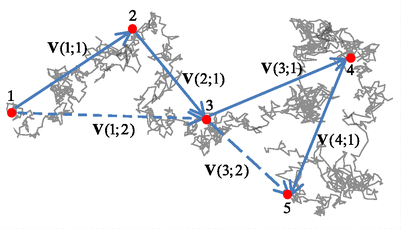
Jamming corresponds to the collective "slowing down" and the eventual "getting stuck" of constitutive particles that make up materials from molecules to colloids to macroscopic objects. How a system's proximity to jamming correlates with the type of local movements by individual particles has been a long standing question. Traditional indicators, such as the mean square displacement, fail to capture many features of the subtle dynamics. At the University of Chicago MRSEC, four research groups---the Dinner, Gardel, Rice, and Scherer groups--have collaboratively developed a new indicator that quantifies change in the directional dynamics near jamming. This new approach is generally applicable for uncovering correlations in the complex directional motions of soft materials, including biomaterials.
The image shows a test case in which a colloidal suspension of micron-sized particles was imaged by video microscopy. Individual particle positions imaged at regular time intervals, are connected by vectors (V) and the angles between successive vectors are determined. The new order parameter, P, is the normalized distribution of angles across all times and across all particles. As the packing density of particles increases, a peak emerges indicating reversals in the motion, representative of caging in a system approaching jamming.